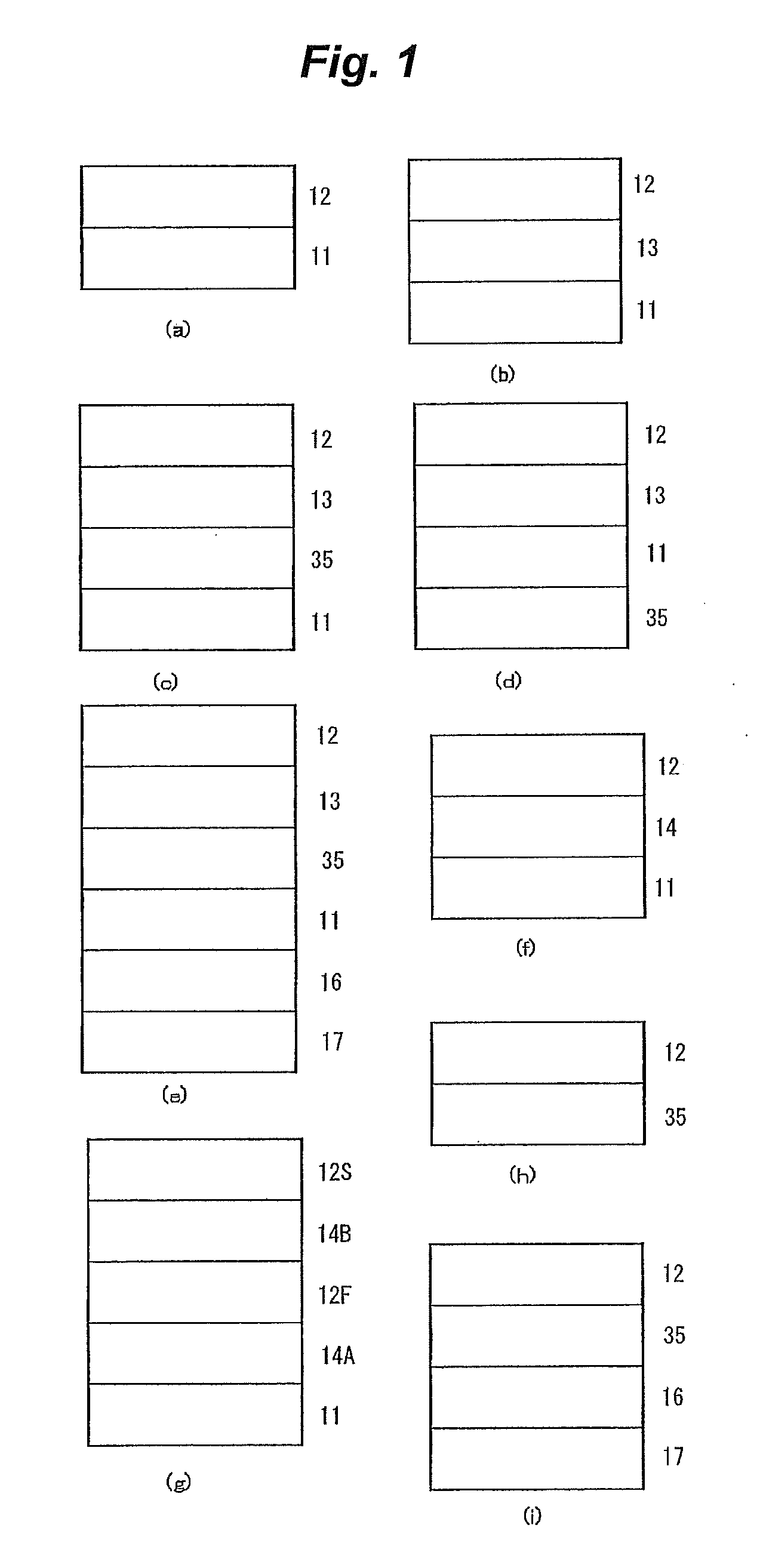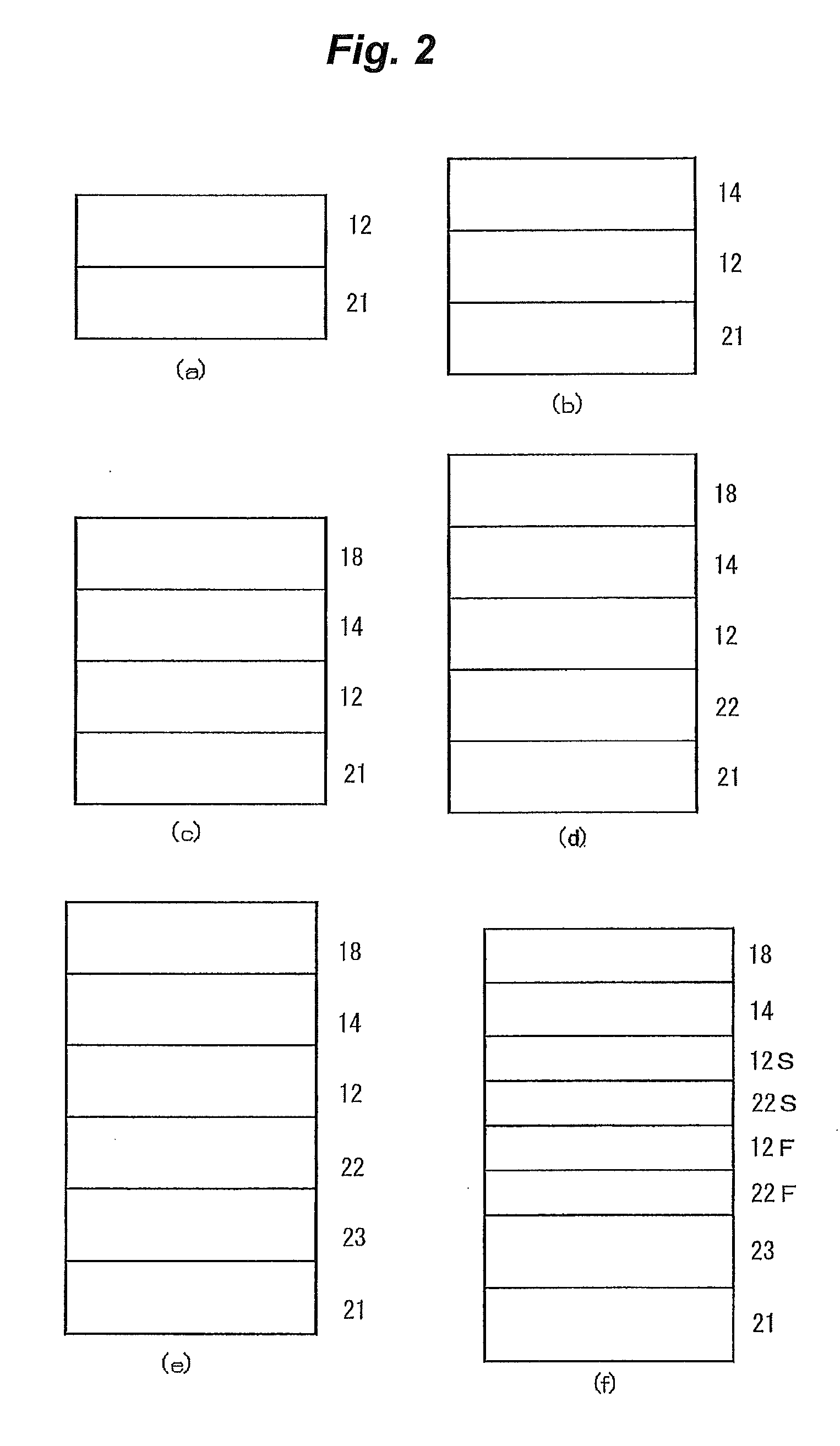Method of producing a patterned birefringent product
a technology of patterned birefringent and product, which is applied in the direction of printing, optics, instruments, etc., can solve the problems of poor heat resistance, the birefringence of the portion will end up decreasing, and it is extremely difficult to create patterns at a resolution lower than the thickness of the film, so as to achieve high heat resistance and resolution.
- Summary
- Abstract
- Description
- Claims
- Application Information
AI Technical Summary
Benefits of technology
Problems solved by technology
Method used
Image
Examples
example 1
Preparation of Birefringent Pattern Builder and Preparation of Birefringent Samples Having a Desired Retardation by Using the Same
(Preparation of Coating Liquid CU-1 for Dynamic Property Control Layer)
[0156]The composition below was prepared, filtered through a polypropylene filter having a pore size of 30 μm, and the filtrate was used as coating liquid CU-1 for forming a dynamic property control layer.
[0157]B-1 was a copolymer of methyl methacrylate, 2-ethylhexyl acrylate, benzyl methacrylate and methacrylic acid, having a copolymerization composition ratio (molar ratio) of 55 / 30 / 10 / 5, a mass-average molecular mass of 100,000, and a Tg of about 70° C.
[0158]B-2 was a copolymer of styrene and acrylic acid having a copolymerization composition ratio (molar ratio) of 65 / 35, a mass-average molecular mass of 10,000, and a Tg of about 100° C.
Composition of Coating Liquidfor Dynamic Property Control Layer(% by mass)Binder (B-1)5.89Binder (B-2)13.74BPE-500 (trade name, manufactured by Shin-...
example 2
Preparation of Birefringent Samples of which the Relationship Between Exposure Quantity and Post-Baking Retardation was Adjusted by Modification of the Concentration of the Photopolymerization Initiator in the Adhesive Layer for Transfer
(Preparation of Coating Liquids AD-2 and AD-3 for Adhesive Layer for Transfer)
[0171]Coating Liquids AD-2 and AD-3 for adhesive layer for transfer, in which the concentration of the photopolymerization initiator was altered from that in AD-1, were newly prepared and used after they were filtered through a polypropylene filter having a pore size of 0.2 μm. The formulations of AD-2 and AD-3 as well as that of AD-1 for comparison are shown in Table 3. The formulation AD-2 had a photopolymerization initiator concentration lower, while the formulation AD-3 had a photopolymerization initiator concentration higher than that of the formulation AD-1.
TABLE 3Name of formulationComposition of coating liquid (% by mass)AD-1AD-2AD-3Binder (B-3)8.058.098.01KAYARAD D...
example 3
Preparation of Birefringent Samples of which the Relationship Between the Exposure Quantity and the Post-Baking Retardation is Modified According to the Kind of The Photopolymerization Initiator in the Adhesive Layer for Transfer
(Preparation of Coating Liquid AD-4 for Adhesive Layer for Transfer)
[0179]Coating liquid AD-4 for adhesive layer for transfer, in which the kind of the photopolymerization initiator was altered from that in AD-1, was newly prepared and used after it was filtered through a polypropylene filter having a pore size of 0.2 μm. The formulation of AD-4 and that of AD-1 for comparison are shown in Table 6.
[0180]As RPI-2, use was made of 2,4-bis(trichloromethyl)-6-[4-(N,N-diethoxycarbonylmethyl)-3-bromophenyl]-s-triazine.
TABLE 6Name of formulationComposition of coating liquid (% by mass)AD-1AD-4Binder (B-3)8.058.09KAYARAD DPHA (trade name, manufactured by4.834.85Nippon Kayaku)Radical photopolymerization initiator (RPI-1)0.12—Radical photopolymerization initiator (RPI...
PUM
| Property | Measurement | Unit |
|---|---|---|
| wavelength | aaaaa | aaaaa |
| wavelength | aaaaa | aaaaa |
| wavelength | aaaaa | aaaaa |
Abstract
Description
Claims
Application Information
 Login to View More
Login to View More - R&D
- Intellectual Property
- Life Sciences
- Materials
- Tech Scout
- Unparalleled Data Quality
- Higher Quality Content
- 60% Fewer Hallucinations
Browse by: Latest US Patents, China's latest patents, Technical Efficacy Thesaurus, Application Domain, Technology Topic, Popular Technical Reports.
© 2025 PatSnap. All rights reserved.Legal|Privacy policy|Modern Slavery Act Transparency Statement|Sitemap|About US| Contact US: help@patsnap.com



